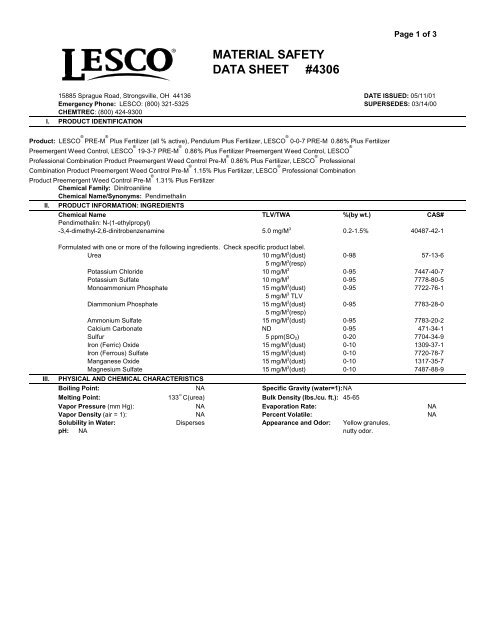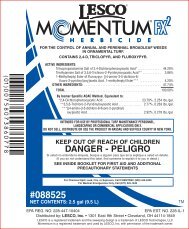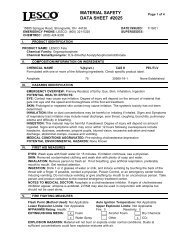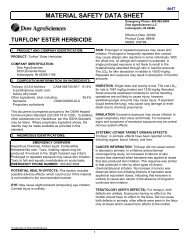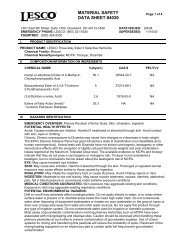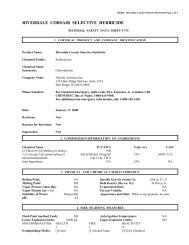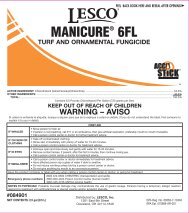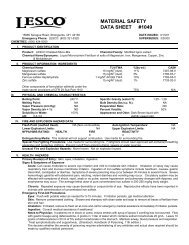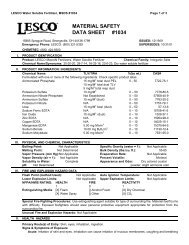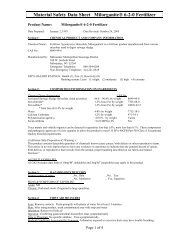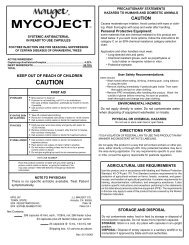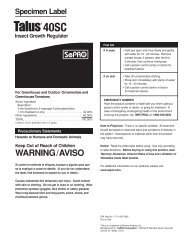MATERIAL SAFETY DATA SHEET #4306 - LoveArboreal.com
MATERIAL SAFETY DATA SHEET #4306 - LoveArboreal.com
MATERIAL SAFETY DATA SHEET #4306 - LoveArboreal.com
You also want an ePaper? Increase the reach of your titles
YUMPU automatically turns print PDFs into web optimized ePapers that Google loves.
Page 1 of 3<br />
<strong>MATERIAL</strong> <strong>SAFETY</strong><br />
<strong>DATA</strong> <strong>SHEET</strong> <strong>#4306</strong><br />
15885 Sprague Road, Strongsville, OH 44136 DATE ISSUED: 05/11/01<br />
Emergency Phone: LESCO: (800) 321-5325 SUPERSEDES: 03/14/00<br />
CHEMTREC: (800) 424-9300<br />
I. PRODUCT IDENTIFICATION<br />
Product: LESCO ® PRE-M ® Plus Fertilizer (all % active), Pendulum Plus Fertilizer, LESCO ® 0-0-7 PRE-M 0.86% Plus Fertilizer<br />
Preemergent Weed Control, LESCO ® 19-3-7 PRE-M ® 0.86% Plus Fertilizer Preemergent Weed Control, LESCO ®<br />
Professional Combination Product Preemergent Weed Control Pre-M ® 0.86% Plus Fertilizer, LESCO ® Professional<br />
Combination Product Preemergent Weed Control Pre-M ® 1.15% Plus Fertilizer, LESCO ® Professional Combination<br />
Product Preemergent Weed Control Pre-M ® 1.31% Plus Fertilizer<br />
Chemical Family: Dinitroaniline<br />
Chemical Name/Synonyms: Pendimethalin<br />
II. PRODUCT INFORMATION: INGREDIENTS<br />
Chemical Name TLV/TWA %(by wt.) CAS#<br />
Pendimethalin: N-(1-ethylpropyl)<br />
-3,4-dimethyl-2,6-dinitrobenzenamine 5.0 mg/M 3 0.2-1.5% 40487-42-1<br />
III.<br />
Formulated with one or more of the following ingredients. Check specific product label.<br />
Urea 10 mg/M 3 (dust) 0-98 57-13-6<br />
5 mg/M 3 (resp)<br />
Potassium Chloride 10 mg/M 3 0-95 7447-40-7<br />
Potassium Sulfate 10 mg/M 3 0-95 7778-80-5<br />
Monoammonium Phosphate 15 mg/M 3 (dust) 0-95 7722-76-1<br />
5 mg/M 3 TLV<br />
Diammonium Phosphate 15 mg/M 3 (dust) 0-95 7783-28-0<br />
5 mg/M 3 (resp)<br />
Ammonium Sulfate 15 mg/M 3 (dust) 0-95 7783-20-2<br />
Calcium Carbonate ND 0-95 471-34-1<br />
Sulfur 5 ppm(SO 2) 0-20 7704-34-9<br />
Iron (Ferric) Oxide 15 mg/M 3 (dust) 0-10 1309-37-1<br />
Iron (Ferrous) Sulfate 15 mg/M 3 (dust) 0-10 7720-78-7<br />
Manganese Oxide 15 mg/M 3 (dust) 0-10 1317-35-7<br />
Magnesium Sulfate 15 mg/M 3 (dust) 0-10 7487-88-9<br />
PHYSICAL AND CHEMICAL CHARACTERISTICS<br />
Boiling Point: NA Specific Gravity (water=1):NA<br />
Melting Point: 133EC(urea) Bulk Density (lbs./cu. ft.): 45-65<br />
Vapor Pressure (mm Hg): NA Evaporation Rate: NA<br />
Vapor Density (air = 1): NA Percent Volatile: NA<br />
Solubility in Water: Disperses Appearance and Odor: Yellow granules,<br />
pH: NA nutty odor.
Page 2 of 3<br />
IV.<br />
FIRE AND EXPLOSION HAZARD <strong>DATA</strong><br />
Flash Point(method Used): NA Auto Ignition Temperature: NA<br />
Lower Explosion Limits: NA Upper Explosion Limits: NA<br />
NFPA/HMIS RATING: HEALTH FIRE REACTIVITY<br />
2 1 0<br />
Extinguishing Media: [X] Foam [] Alcohol Foam [X] Dry Chemical<br />
[X] Water Spray [] Other [X] CO 2<br />
Special Fire-Fighting Procedures: Wear self-contained, positive pressure breathing apparatus and full fire fighting protective clothing. Keep<br />
unnecessary people away. Use as little water as possible. Dike area of fire to prevent pesticide run-off. Use spray or fog - solid stream may cause<br />
spreading.<br />
Do not contaminate personnel or equipment, or handle broken packages or containers without protective equipment as specified in the Exposure<br />
Control Section. Decontaminate emergency personnel with soap and water beforeleaving the fire area<br />
Avoid breathing dusts, vapors and fumes from burning materials. Control run-off water - if water enters a drainage system, advise the authorities<br />
downstream.<br />
Avoid heavy dose streams; airborne dusts may create an explosion hazard. Fertilizer will be<strong>com</strong>e slippery when wet. Guard against falls.<br />
Unusual Fire and Explosion Hazards: This material has been tested in a 20-liter spherical bomb and has been found to be a Class ST-1 dust<br />
explosion hazard. If the material is further processed, the dust explosion hazard may change and it should be retested. At high temperatures,<br />
nitrogen containing fertilizer can form cyanuric acid, hydrogen cyanide and ammonia. Ammonium carbamate may also be formed. Contamination<br />
with strong acids may create an explosion hazard. Fertilizer will be<strong>com</strong>e slippery when wet. Guard against falls.<br />
V. HEALTH HAZARDS<br />
Primary Route(s) of Entry: Skin, eyes, inhalation, ingestion.<br />
Signs & Symptoms of Exposure<br />
Acute: The <strong>com</strong>bined acute oral LD 50 in male and female rats was greater than 5000 mg/kg, indicating that the material is practically non-toxic by<br />
ingestion in single doses.<br />
The <strong>com</strong>bined acute dermal LD 50 in male and female rabbits was greater than 2000 mg/kg, indicating the product is no more than slightly toxic by<br />
single skin applications.<br />
The material was moderately irritating to both eye and skin in animal studies (rabbit).<br />
Based upon results of a sensitization study in guinea pigs, PRE-M 60 DG was considered a non-sensitizing agent. Direct contact of this product<br />
with the skin or sclera of the eyes may cause orange-yellow staining which will, however, fade in time.<br />
Chronic: Pendimethalin:<br />
Mutagenicity: In an evaluation of data from a battery of six genotoxicity tests, pendimethalin was judged to be nongenotoxic.<br />
Teratogenicity: No teratogenic or fetotoxic effects were observed in rats or rabbits.<br />
Reproduction: No reproductive effects were observed in a three-generation reproduction study conducted with rats.<br />
Oncogenicity: No oncogenic effects were observed at all dosed levels tested in the lifetime (18 months) mouse study.<br />
The highest dose tested was 5000 ppm in the diet.<br />
A marked depression in body weight gain and statistically significant increase in benign thyroid proliferative lesions were observed at the highest<br />
dose tested (5000 ppm) in the lifetime (24 months) rat study.<br />
Emergency First-Aid Procedures<br />
Eyes: Flush with copious amounts of water. Get medical attention if irritation persists.<br />
Skin: Remove contaminated clothing. Wash with soap and water. Get medical attention if irritation persists.<br />
Inhalation: Remove to fresh air.<br />
Ingestion: Drink two glasses of water. Induce vomiting by touching the back of the throat with fingers.<br />
Notes to Physician: Pendimethalin is a strongly orange-red colored <strong>com</strong>pound - virtually an aniline dye. Cases have been described of<br />
orange-yellow coloration of the urine following heavy exposure of workers to the dust of this <strong>com</strong>pound. Despite its structure as both a nitro<strong>com</strong>pound<br />
and aromatic amine, exposure to pendimethalin is NOT associated with methemoglobinemia.<br />
Toxicity Information:<br />
Oral LD 50: Acute(rat): >5000 mg/kg Dermal LD 50: Acute(rabbit): >2000 mg/kg<br />
Eye Irritation: Moderate Skin Irritation: Moderate, non-sensitizing<br />
Positive Teratogen or Mutagen Carcinogen(NTP): No<br />
Potential Carcinogen (IARC or OSHA): No<br />
VI.<br />
REACTIVITY<br />
Stability: [X] Stable [ ] Unstable<br />
Conditions to Avoid: None<br />
In<strong>com</strong>patibility: Avoid contamination with oxidizing agents or strong alkalies.<br />
Hazardous De<strong>com</strong>position Products: Possible <strong>com</strong>bustion products include oxides of carbon, sulfur and nitrogen. Urea also de<strong>com</strong>poses to<br />
biuret and cyanuric acid. Urea reacts with sodium or calcium hypochlorite to form explosive nitrogen trichloride.<br />
Hazardous Polymerization: [X] Will not occur [ ] Will occur
Page 3 of 3<br />
VII.<br />
VIII.<br />
SPILL, LEAK, AND DISPOSAL PROCEDURES<br />
If material is spilled: If dry, sweep or shovel into a container for reuse per label instructions or disposal. If liquid, contain spill and absorb with inert<br />
material and place in container for disposal. Prevent from entering drains, sewers or water sources. Avoid contact with skin, eyes, clothing.<br />
Waste Disposal Method: Dispose according to Federal EPA procedures as outlined in the Resource Conservation Recovery Act (RCRA) and<br />
follow state and local guidelines. Be sure containers are <strong>com</strong>pletely empty before disposal.<br />
SPECIAL PROTECTION INFORMATION<br />
Protective Equipment Suggested for Outdoor Application:<br />
[X] Impervious Gloves [ ] Dust Mask [ ] Respirator(use NIOSH/MSHA approved)<br />
[X] Impervious Boots [X] Clean Clothing [X] Eye Goggles / Safety Glasses<br />
Protective Equipment Suggested for Confined Areas:<br />
[X] Sufficient Ventilation [X] Respirator(use NIOSH/MSHA approved)<br />
[X] Dust Mask<br />
[X] Splash Goggles/Safety Glasses<br />
[X] Eyewash Station [X] Emergency Shower [ ] Impervious Apron<br />
IX. STORAGE AND HANDLING<br />
Precautions: Store in a cool, dry place if possible. Separate from other pesticides, fertilizers, seed, feed, foodstuffs, and away from drains, sewers,<br />
and water sources.<br />
Other Precautions: Do not store in temperatures above 120EF. Keep away from fire, sparks or other ignition sources. Segregate from oxidizers<br />
and in<strong>com</strong>patible material listed under Reactivity Data Section. Due to dust explosion hazard, all equipment should have explosion venting per<br />
NFPA 68-1978. All electrical wiring and equipment should meet the provisions of NFPA-70. Store in original, unopened or sealed containers. Do<br />
not store in unmarked containers. Wash thoroughly with soap and water after handling.<br />
X. FEDERAL REGULATORY INFORMATION:<br />
SARA TITLE III; SEC. 311/312 HAZARD CATEGORIES<br />
N Immediate (acute Health) SEC 302: NA<br />
N Delayed (Chronic) Health SEC 304: NA<br />
N Fire<br />
SEC 313: NA<br />
N Sudden Release of Pressure<br />
CERCLA RQ: NA<br />
N Reactivity<br />
CAA RQ: NA<br />
EPA Reg. No.: 10404-82, 538-214-10404<br />
HM 181 Shipping Name: Not Regulated.<br />
NA = Not Applicable<br />
ND = Not Determined<br />
Preparation and distribution of this Material Safety Data Sheet done by LESCO, Inc., 15885 Sprague Road, Strongsville, OH 44136-1799, pursuant to the<br />
OSHA Hazard Communication Standard (29 CFR 1910.1200).<br />
The information contained herein is based on available data. However, no warranty is expressed or implied regarding the accuracy of this data or the results to be obtained from the use thereof;<br />
and you should make your investigation to determine safety for the use you contemplate. LESCO, Inc. makes no warranty of merchantability of fitness for a particular use, nor is there any other<br />
express or implied warranty except as may be specifically provided otherwise on product.<br />
LESCO, Inc. assumes no responsibility or liability for any incidental or consequential damages whether related to personal injury or property damage, to vendees, users or third parties, caused<br />
by the material; and LESCO, Inc.'s responsibility is limited to replacement of, or repayment of, the purchase price for the material(s) with respect to which any damages are claimed. All vendees<br />
or users assume all risk associated with the use of the material(s).<br />
For further information, contact: LESCO, Inc., • 15885 Sprague Road • Strongsville, OH 44136-1799 or (800) 321-5325.<br />
G:\REGUL\WP\STRONGSV\MSDS - LESCO Strongsville\4306pre-m+f.msd.doc05/11/01wpv


